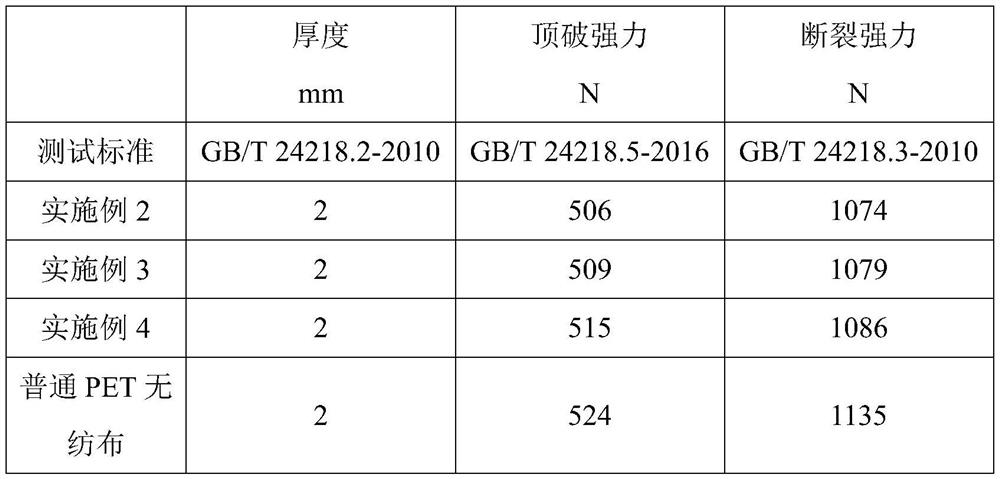Bio-based polyester non-woven fabric and preparation method thereof
A polyester non-woven fabric, bio-based technology, applied in the direction of non-woven fabrics, rayon manufacturing, textiles and papermaking, etc., can solve the problems of poor mechanical properties, non-degradable, non-durable, etc., to achieve easy operation, save manpower and The effect of equipment cost, bursting strength and breaking strength
- Summary
- Abstract
- Description
- Claims
- Application Information
AI Technical Summary
Problems solved by technology
Method used
Image
Examples
Embodiment 1
[0057] A kind of bio-based polyester non-woven fabric, described bio-based polyester non-woven fabric is made by bio-based polyester filament through spunlace process;
[0058] The bio-based polyester filament is made from raw materials comprising the following parts by weight:
[0059] 80-88 parts of bio-based succinate-pentanediol copolyester,
[0060] 12-16 parts of bio-based polypentamethylene adipate,
[0061] 6-9 parts of thermoplastic elastomer,
[0062] 1.5-2.5 parts of carboxylated carbon nanotubes,
[0063] Quartz fiber 2 to 3.5 parts,
[0064] 3-5 parts of calcium carbonate,
[0065] 0.8-1.2 parts of cerium oxide,
[0066] 5-7 parts of maleic anhydride grafted polypropylene;
[0067] The bio-based polypentamethylene adipate is prepared by polymerizing bio-based adipic acid and petroleum-based 1,5-pentanediamine;
[0068] The bio-based succinate-pentanediol copolyester is prepared by polymerizing petroleum-based succinic acid and bio-based 1,5-pentanediol.
[0...
Embodiment 2
[0091] A kind of bio-based polyester non-woven fabric, described bio-based polyester non-woven fabric is made by bio-based polyester filament through spunlace process;
[0092] The bio-based polyester filament is made of raw materials comprising the following parts by weight:
[0093] 80 parts of bio-based succinate-pentanediol copolyester,
[0094] 12 parts of bio-based polypentamethylene adipate,
[0095] Thermoplastic elastomer 6 parts,
[0096] 1.5 parts of carboxylated carbon nanotubes,
[0098] 3 parts calcium carbonate,
[0099] 0.8 parts of cerium dioxide,
[0100] 5 parts of maleic anhydride grafted polypropylene;
[0101] The bio-based polypentamethylene adipate is prepared by polymerizing bio-based adipic acid and petroleum-based 1,5-pentanediamine;
[0102] The bio-based succinate-pentanediol copolyester is prepared by polymerizing petroleum-based succinic acid and bio-based 1,5-pentanediol.
[0103] In this embodiment, the th...
Embodiment 3
[0116] A kind of bio-based polyester non-woven fabric, described bio-based polyester non-woven fabric is made by bio-based polyester filament through spunlace process;
[0117] The bio-based polyester filament is made of raw materials comprising the following parts by weight:
[0118] 88 parts of bio-based succinate-pentanediol copolyester,
[0119] 16 parts of bio-based polypentamethylene adipate,
[0120] 9 parts of thermoplastic elastomer,
[0121] 2.5 parts of carboxylated carbon nanotubes,
[0122] 3.5 parts of quartz fiber,
[0123] 5 parts of calcium carbonate,
[0124] 1.2 parts of cerium dioxide,
[0125] 7 parts of maleic anhydride grafted polypropylene;
[0126] The bio-based polypentamethylene adipate is prepared by polymerizing bio-based adipic acid and petroleum-based 1,5-pentanediamine;
[0127] The bio-based succinate-pentanediol copolyester is prepared by polymerizing petroleum-based succinic acid and bio-based 1,5-pentanediol.
[0128] In this embodim...
PUM
 Login to View More
Login to View More Abstract
Description
Claims
Application Information
 Login to View More
Login to View More - R&D
- Intellectual Property
- Life Sciences
- Materials
- Tech Scout
- Unparalleled Data Quality
- Higher Quality Content
- 60% Fewer Hallucinations
Browse by: Latest US Patents, China's latest patents, Technical Efficacy Thesaurus, Application Domain, Technology Topic, Popular Technical Reports.
© 2025 PatSnap. All rights reserved.Legal|Privacy policy|Modern Slavery Act Transparency Statement|Sitemap|About US| Contact US: help@patsnap.com

